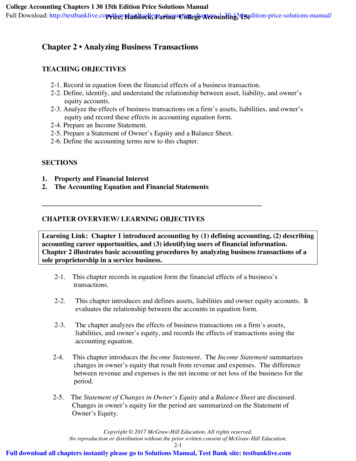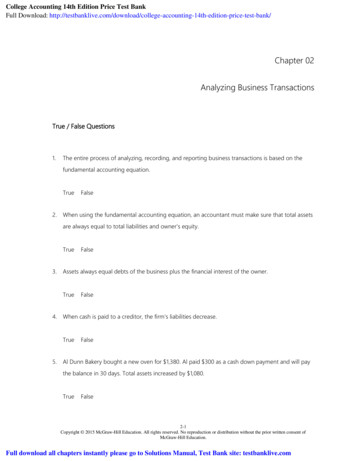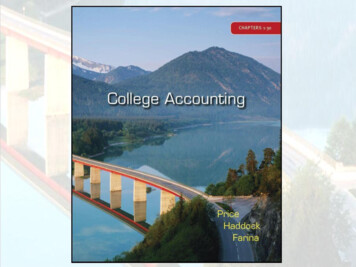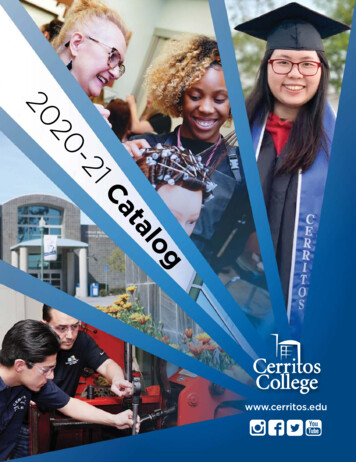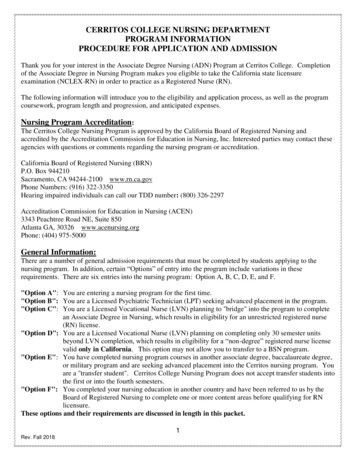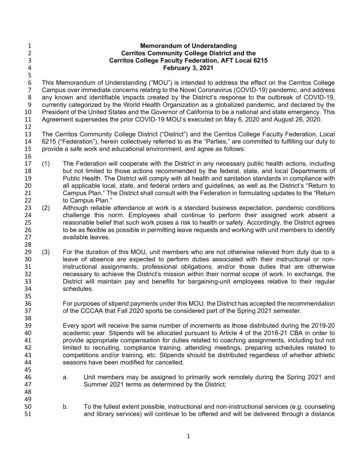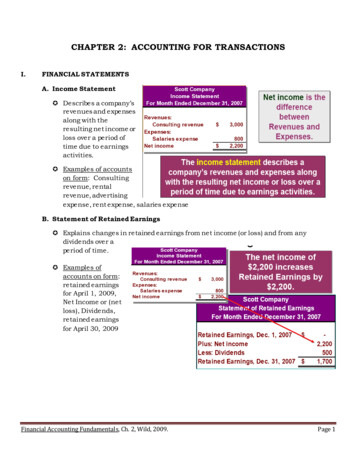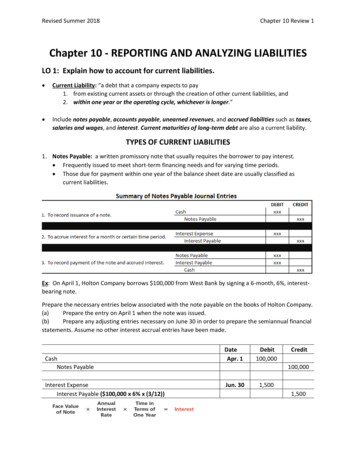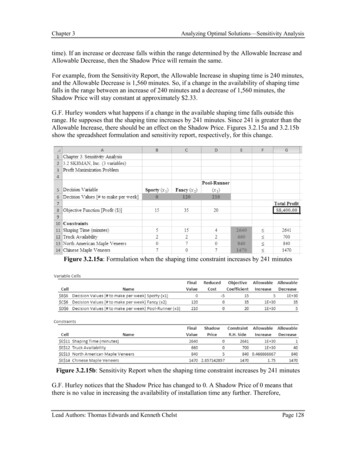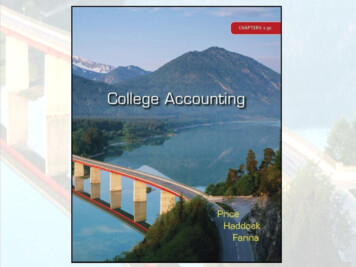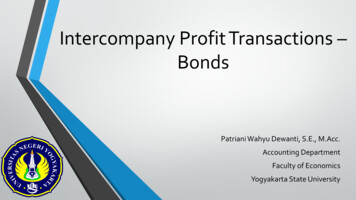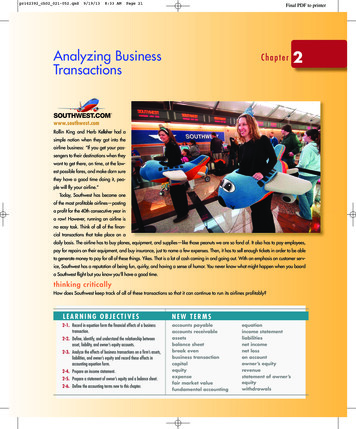
Transcription
pri62392 ch02 021-052.qxd9/19/138:33 AMPage 21Final PDF to printerAnalyzing n King and Herb Kelleher had asimple notion when they got into theairline business: “If you get your passengers to their destinations when theywant to get there, on time, at the lowest possible fares, and make darn surethey have a good time doing it, people will fly your airline.”Today, Southwest has become oneof the most profitable airlines—postinga profit for the 40th consecutive year ina row! However, running an airline isno easy task. Think of all of the financial transactions that take place on adaily basis. The airline has to buy planes, equipment, and supplies—like those peanuts we are so fond of. It also has to pay employees,pay for repairs on their equipment, and buy insurance, just to name a few expenses. Then, it has to sell enough tickets in order to be ableto generate money to pay for all of these things. Yikes. That is a lot of cash coming in and going out. With an emphasis on customer service, Southwest has a reputation of being fun, quirky, and having a sense of humor. You never know what might happen when you boarda Southwest flight but you know you’ll have a good time.thinking criticallyHow does Southwest keep track of all of these transactions so that it can continue to run its airlines profitably?LEARNING OBJECTIVESNEW TERMS2-1. Record in equation form the financial effects of a businesstransaction.accounts payableaccounts receivableassetsbalance sheetbreak evenbusiness transactioncapitalequityexpensefair market valuefundamental accounting2-2. Define, identify, and understand the relationship betweenasset, liability, and owner’s equity accounts.2-3. Analyze the effects of business transactions on a firm’s assets,liabilities, and owner’s equity and record these effects inaccounting equation form.2-4. Prepare an income statement.2-5. Prepare a statement of owner’s equity and a balance sheet.2-6. Define the accounting terms new to this chapter.equationincome statementliabilitiesnet incomenet losson accountowner’s equityrevenuestatement of owner’sequitywithdrawals
pri62392 ch02 021-052.qxdSection 9/19/138:33 AMPage 221SECTION OBJECTIVESTERMS TO LEARN2-1. Record in equation form the financial effects of a business transaction.accounts payableassetsbalance sheetbusiness transactioncapitalequityliabilitieson accountowner’s equityWHY IT’S IMPORTANTLearning the fundamental accounting equation is a basis for understanding businesstransactions. Final PDF to printer2-2. Define, identify, and understand the relationship between asset,liability, and owner’s equity accounts.WHY IT’S IMPORTANTThe relationship between assets, liabilities, and owner’s equity is the basis for the entireaccounting system.Property andFinancial InterestThe accounting process starts with the analysis of business transactions. A business transactionis any financial event that changes the resources of a firm. For example, purchases, sales, payments, and receipts of cash are all business transactions. The accountant analyzes each businesstransaction to decide what information to record and where to record it. 2-1. OBJECTIVERecord in equation form the financialeffects of a business transaction.Beginning with AnalysisLet’s analyze the transactions of Wells’ Consulting Services, a firm that provides a wide rangeof accounting and consulting services. Carolyn Wells, CPA, has a master’s degree in accounting. She is the sole proprietor of Wells’ Consulting Services. Carlos Valdez, the office manager,has an associate’s degree in business and has taken 12 semester hours of accounting. The firmis located in a large office complex.Every month, Wells’ Consulting Services bills clients for the accounting and consultingservices provided that month. Customers can also pay in cash when the services are rendered.STARTING A BUSINESSLet’s start from the beginning. Carolyn Wells obtained the funds to start the business by withdrawing 100,000 from her personal savings account. The first transaction of the new businesswas opening a checking account in the name of Wells’ Consulting Services. The separate bankaccount helps Wells keep her financial interest in the business separate from her personal funds.When a business transaction occurs, it is analyzed to identify how it affects the equationproperty equals financial interest. This equation reflects the fact that in a free enterprise system, all property is owned by someone. In this case, Wells owns the business because she supplied the property (cash).Use these steps to analyze the effect of a business transaction:221. Describe the financial event. Identify the property. Identify who owns the property. Determine the amount of increase or decrease.
pri62392 ch02 021-052.qxd9/19/138:33 AMPage 23Final PDF to printerAnalyzing Business Transactions2. Make sure the equation is in balance.PropertyFinancial Interest5BUSINESS TRANSACTIONCarolyn Wells withdrew 100,000 from personal savings and deposited it in a new checkingaccount in the name of Wells’ Consulting Services. ANALYSISa. The business received 100,000 of property in the form of cash.a. Wells had a 100,000 financial interest in the business.Note that the equation property equals financial interest remains in balance. The total of oneside of the equation must always equal the total of the other side.PropertyCash(a) Invested cash(a) Increased equityNew balances5Financial Interest5Carolyn Wells, Capital1 100,0001 100,000 100,0005 100,000An owner’s financial interest in the business is called equity, or capital. Carolyn Wellshas 100,000 equity in Wells’ Consulting Services.PURCHASING EQUIPMENT FOR CASHThe first priority for office manager Carlos Valdez was to get the business ready for openingday on December 1.BUSINESS TRANSACTIONWells’ Consulting Services issued a 5,000 check to purchase a computer and other equipment. ANALYSISb. The firm purchased new property (equipment) for 5,000.b. The firm paid out 5,000 in cash.The equation remains in balance.CHAPTER 223
pri62392 ch02 021-052.qxd249/19/13CHAPTER 28:33 AMPage 24Final PDF to printerAnalyzing Business TransactionsPropertyFinancial Interest5CashPrevious balances(b) Purchased equipment(b) Paid cashEquipment1 100,0001 5,0001 5,000Carolyn Wells, Capital55 100,0005 100,00025,000New balances 95,000Notice that there is a change in the composition of the firm’s property. Now the firm hascash and equipment. The equation shows that the total value of the property remains the same, 100,000. Carolyn Wells’ financial interest, or equity, is also unchanged. Note that property(Cash and Equipment) is equal to financial interest (Carolyn Wells, Capital).These activities are recorded for the business entity Wells’ Consulting Services. CarolynWells’ personal assets, such as her personal bank account, house, furniture, and automobile, arekept separate from the property of the firm. Nonbusiness property is not included in theaccounting records of the business entity.PURCHASING EQUIPMENT ON CREDITValdez purchased additional office equipment. Office Plus, the store selling the equipment,allows Wells’ Consulting Services 60 days to pay the bill. This arrangement is called buyingon account. The business has a charge account, or open-account credit, with its suppliers.Amounts that a business must pay in the future are known as accounts payable. The companies or individuals to whom the amounts are owed are called creditors.BUSINESS TRANSACTIONWells’ Consulting Services purchased office equipment on account from Office Plus for 6,000. ANALYSISc. The firm purchased new property (equipment) that cost 6,000.c. The firm owes 6,000 to Office Plus.The equation remains in balance.PropertyABOUTACCOUNTINGHistoryFor as long as people have beeninvolved in business, there has been aneed for accounting. The system ofaccounting we use is based upon theworks of Luca Pacioli, a Franciscanmonk in Italy. In 1494, Pacioli wroteabout the bookkeeping techniques inpractice during his time.5Cash1Equipment5Previous balances(c) Purchased equip.(c) Incurred debt 95,00011 5,0006,00055New balances 95,000Financial InterestAccountsPayable1Carolyn Wells,Capital 100,0001 6,0001 11,0005 6,000 1 100,000Office Plus is willing to accept a claim against Wells’ Consulting Services until the bill ispaid. Now there are two different financial interests or claims against the firm’s property—thecreditor’s claim (Accounts Payable) and the owner’s claim (Carolyn Wells, Capital). Notice
pri62392 ch02 021-052.qxd9/19/138:33 AMPage 25Final PDF to printerAnalyzing Business TransactionsCHAPTER 2that the total property increases to 106,000. Cash is 95,000 and equipment is 11,000.Carolyn Wells, Capital stays the same; but the creditor’s claim increases to 6,000. After thistransaction is recorded, the left side of the equation still equals the right side.When Ben Cohen and Jerry Greenfield founded Ben & Jerry’s Homemade Ice Cream, Inc., in 1978,they invested 8,000 of their own funds and borrowed funds of 4,000. The equation property equalsfinancial interest is expressed asPropertycash55 12,0005Financial Interestcreditors’ claims1 owners’ claims 4,00018,000 12,000PURCHASING SUPPLIESValdez purchased supplies so that Wells’ Consulting Services could start operations. The company that sold the items requires cash payments from companies that have been in business lessthan six months.BUSINESS TRANSACTIONWells’ Consulting Services issued a check for 1,500 to Office Delux, Inc., to purchase officesupplies. ANALYSISd. The firm purchased office supplies that cost 1,500.d. The firm paid 1,500 in cash.The equation remains in balance.PropertyCashPrevious balances(d) Purchased supplies(d) Paid cashFinancial Interest51Supplies1 1,5001 1,500 95,0001Equipment5AccountsPayable1Carolyn Wells,Capital1 11,0005 6,0001 100,0001 11,0005 6,0001 100,0002 1,500New balances 93,500Notice that total property remains the same, even though the form of the property has changed.Also note that all of the property (left side) equals all of the financial interests (right side).PAYING A CREDITORValdez decided to reduce the firm’s debt to Office Plus by 2,500.25
pri62392 ch02 021-052.qxd269/19/138:33 AMPage 26Final PDF to printerAnalyzing Business TransactionsCHAPTER 2BUSINESS TRANSACTIONWells’ Consulting Services issued a check for 2,500 to Office Plus. ANALYSISe. The firm paid 2,500 in cash.e. The claim of Office Plus against the firm decreased by 2,500.The equation remains in balance.PropertyPrevious balances(e) Paid cash(e) Decreased debtNew balancesFinancial arolyn Wells,Capital 93,5002 2,5001 1,5001 11,0005 6,0001 100,0001 100,0002 2,500 91,0001 1,5001 11,000 3,5005RENTING FACILITIESIn November, Valdez arranged to rent facilities for 4,000 per month, beginning in December.The landlord required that rent for the first two months—December and January—be paid inadvance. The firm prepaid (paid in advance) the rent for two months. As a result, the firmobtained the right to occupy facilities for a two-month period. In accounting, this right is considered a form of property.BUSINESS TRANSACTIONWells’ Consulting Services issued a check for 8,000 to pay for rent for the months of Decemberand January. ANALYSISf. The firm prepaid the rent for the next two months in the amount of 8,000.f. The firm decreased its cash balance by 8,000.The equation remains in balance.PropertyPrevious balances(f) Paid cash(f) Prepaid rentNew balancesCash1Supplies 91,0002 8,0001 1,50051PrepaidRentFinancial Interest1Equipment5AccountsPayable1Carolyn Wells,Capital1 11,0005 3,5001 100,0001 11,0005 3,5001 100,0001 8,000 83,0001 1,5001 8,000
pri62392 ch02 021-052.qxd9/19/138:33 AMPage 27Final PDF to printerAnalyzing Business TransactionsCHAPTER 227Notice that when property values and financial interests increase or decrease, the total of theitems on one side of the equation still equals the total on the other side.PropertyCash5 83,000Supplies1,500Prepaid Rent8,000EquipmentTotalFinancial InterestAccounts Payable 3,500Carolyn Wells, Capital100,00011,000 103,500Total 103,500The balance sheet is also called the statement of financial position. Caterpillar Inc. reported assets of 89.4billion, liabilities of 71.8 billion, and owners’ equity of 17.6 billion on its statement of financial positionat December 31, 2012.Assets, Liabilities, and Owner’s Equity 2-2. OBJECTIVEAccountants use special accounting terms when they refer to property and financial interests.For example, they refer to the property that a business owns as assets and to the debts or obligations of the business as liabilities. The owner’s financial interest is called owner’s equity.(Sometimes owner’s equity is called proprietorship or net worth. Owner’s equity is the preferred term and is used throughout this book.) At regular intervals, Wells reviews the status ofthe firm’s assets, liabilities, and owner’s equity in a financial statement called a balance sheet.The balance sheet shows the firm’s financial position on a given date. Figure 2.1 shows thefirm’s balance sheet on November 30, the day before the company opened for business.The assets are listed on the left side of the balance sheet and the liabilities and owner’sequity are on the right side. This arrangement is similar to the equation property equals financial interest. Property is shown on the left side of the equation, and financial interest appears onthe right side.The balance sheet in Figure 2.1 shows: Define, identify, and understand therelationship between asset, liability,and owner’s equity accounts.the amount and types of property the business owns,the amount owed to creditors,the owner’s interest.This statement gives Carolyn Wells a complete picture of the financial position of her business on November 30.FIGURE 2.1Balance Sheet for Wells’ Consulting ServicesWells’ Consulting ServicesBalance SheetNovember 30, 2016LiabilitiesAssetsCashSuppliesPrepaid RentEquipmentTotal Assets8318111030500500000000000000000000Accounts PayableOwner’s EquityCarolyn Wells, CapitalTotal Liabilities and Owner’s Equity3 5 0 0 00100 0 0 0 00103 5 0 0 00
pri62392 ch02 021-052.qxd28CHAPTER 2Section19/19/138:33 AMPage 28Final PDF to printerAnalyzing Business TransactionsSelf ReviewQUESTIONS1. Describe a transaction that increases an asset andthe owner’s equity.2. What does the term “accounts payable” mean?3. What is a business transaction?EXERCISES4. John Ellis began a new business by depositing 150,000 in the business bank account. He wrotetwo checks from the business account: 24,000for office furniture and 8,000 for office supplies.What is his financial interest in the company?a. 122,000b. 118,0005.c. 126,000d. 150,000Teresa Wells purchased a computer for 2,950 onaccount for her business. What is the effect of thistransaction?a. Equipment increase of 2,950 and accountspayable increase of 2,950.b. Equipment decrease of 2,950 and accountspayable increase of 2,950.c. Equipment increase of 2,950 and cashincrease of 2,950.d. Cash decrease of 2,950 and owner’s equityincrease of 2,950.A N A LY S I S6.China Import Co. has no liabilities. The asset andowner’s equity balances are as follows. What isthe balance of “Supplies”?Cash 50,000Office Equipment 30,000Supplies?John Wong, Capital 100,000(Answers to Section 1 Self Review are onpage 50.)
pri62392 ch02 021-052.qxdSection 9/19/138:33 AMPage 29Final PDF to printer2SECTION OBJECTIVESTERMS TO LEARN2-3. Analyze the effects of business transactions on a firm’s assets, liabilities, and owner’s equity and record these effects in accounting equation form.accounts receivablebreak evenexpensefair market valuefundamental accountingequationincome statementnet incomenet lossrevenuestatement of owner’s equitywithdrawalsWHY IT’S IMPORTANTProperty will always equal financial interest. 2-4. Prepare an income statement.WHY IT’S IMPORTANTThe income statement shows the results of operations. 2-5. Prepare a statement of owner’s equity and a balance sheet.WHY IT’S IMPORTANTThese financial statements show the financial condition of a business.The Accounting Equationand Financial StatementsThe word balance in the title “balance sheet” has a special meaning. It emphasizes that the totalon the left side of the report must equal, or balance, the total on the right side.The Fundamental Accounting EquationIn accounting terms, the firm’s assets must equal the total of its liabilities and owner’s equity.This equality can be expressed in equation form, as illustrated here. The amounts are for Wells’Consulting Services on November 30.Assets5Liabilities1Owner’s Equity 103,5005 3,5001 100,000 2-3. OBJECTIVEAnalyze the effects of businesstransactions on a firm’s assets,liabilities, and owner’s equity andrecord these effects in accountingequation form.The relationship between assets and liabilities plus owner’s equity is called the fundamentalaccounting equation. The entire accounting process of analyzing, recording, and reportingbusiness transactions is based on the fundamental accounting equation.If any two parts of the equation are known, the third part can be determined. For example,consider the basic accounting equation for Wells’ Consulting Services on November 30, withsome information missing.Assets5Liabilities1Owner’s Equity5 3,5001 100,0002. 103,5005?1 100,0003. 103,0005 3,5001?1.?In the first case, we can solve for assets by adding liabilities to owner’s equity ( 3,500 1 100,000) to determine that assets are 103,500. In the second case, we can solve for liabilitiesby subtracting owner’s equity from assets ( 103,500 2 100,000) to determine that liabilitiesare 3,500. In the third case, we can solve for owner’s equity by subtracting liabilities fromassets ( 103,500 2 3,500) to determine that owner’s equity is 100,000.important!Revenues increase owner’s equity.Expenses decrease owner’s equity.29
pri62392 ch02 021-052.qxd309/19/138:33 AMPage 30Final PDF to printerAnalyzing Business TransactionsCHAPTER 2EARNING REVENUE AND INCURRING EXPENSESWells’ Consulting Services opened for business on December 1. Some of the other businessesin the office complex became the firm’s first clients. Wells also used her contacts in the community to identify other clients. Providing services to clients started a stream of revenue for thebusiness. Revenue, or income, is the inflow of money or other assets that results from thesales of goods or services or from the use of money or property. A sale on account does notincrease money, but it does create a claim to money. When a sale occurs, the revenue increasesassets and also increases owner’s equity.An expense, on the other hand, involves the outflow of money, the use of other assets, orthe incurring of a liability. Expenses include the costs of any materials, labor, supplies, andservices used to produce revenue. Expenses cause a decrease in owner’s equity.A firm’s accounting records show increases and decreases in assets, liabilities, and owner’sequity as well as details of all transactions involving revenue and expenses. Let’s use the fundamental accounting equation to show how revenue and expenses affect the business.SELLING SERVICES FOR CASHDuring the month of December, Wells’ Consulting Services earned a total of 36,000in revenue from clients who paid cash for accounting and bookkeeping services. Thisinvolved several transactions throughout the month. The total effect of these transactions isanalyzed below. ANALYSISg. The firm received 36,000 in cash for services provided to clients.g. Revenues increased by 36,000, which results in a 36,000 increase in owner’s equity.The fundamental accounting equation remains in balance.AssetsCashPrevious balances(g) Received cash(g) Increasedowner’s equityby earning revenueNew balances1 83,000 11 36,000 119,000 15Liabilities1Owner’s EquitySupplies1PrepaidRent1Equipment5Accoun
Analyzing Business Transactions 2-1. Record in equation form the financial effects of a business transaction. 2-2. Define, identify, and understand the relationship between asset, liability, and owner’s equity accounts. 2-3. Analyze the effects of business transactions on a firm’s assets, liabilities, and owner’s equity and record these .File Size: 1MB
